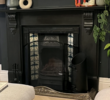- Joined
- 17 May 2022
- Messages
- 11
- Reaction score
- 0
- Country

We're in the process of putting a new kitchen in our existing living room. However, I've only just realised that by having a ducted hob extractor in the same room as an open flued appliance, this will not be in alignment with building regulations.
We're not opposed to not using the fire any longer but would we actually have to remove it to be compliant? My local building regulations department haven't been particularly helpful in giving me a clear answer on this. We essentially want to keep it as decorative as it's one of the original features of the house (it's a Victorian terrace).
We're not opposed to not using the fire any longer but would we actually have to remove it to be compliant? My local building regulations department haven't been particularly helpful in giving me a clear answer on this. We essentially want to keep it as decorative as it's one of the original features of the house (it's a Victorian terrace).

